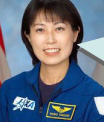JAXA Astronaut Activity Report, November 2007
Last Updated: January 23, 2008
This is JAXA's Japanese astronaut primary activity report for November 2007.
1J/A NASA-JAXA Joint Multi-Segment Training (JMST)
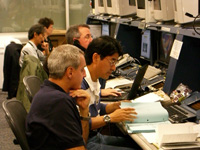
Astronaut Doi participating in the JMST at NASA Johnson Space Center (JSC)
Astronaut Doi, his fellow STS-123 (1J/A Flight) mission crew members, astronaut Yamazaki, and the NASA and JAXA flight controllers for the STS-123 mission participated in Joint Multi-Segment Training (JMST) that simulated mission-specific operations and communication procedures planned for the STS-123 mission.
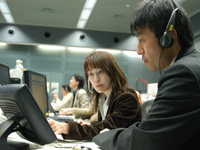
Astronaut Yamazaki participating in the JMST at Tsukuba Space Center (TKSC)
Astronaut Yamazaki, assigned as a Crew Support Astronaut for Astronaut Doi, will be a member of the JAXA Flight Control Team (JFCT) at Tsukuba Space Center (TKSC) during the STS-123 Mission. Astronaut Yamazaki will serve as a JEM Communicator (J-COM) and will be responsible for communications with the astronauts working with the Japanese Experiment Module Kibo.
The JMST simulated the operations and procedures for installing the Kibo Experiment Logistics Module-Pressurized Section (ELM-PS) on the International Space Station (ISS) by following the time line for each flight day. The JMST also simulated the procedures for entering the ELM-PS after installation. The JMST deepened the understanding and cooperation between the astronauts and the NASA and JAXA flight controllers.
ISS Emergency Fire Drill Training
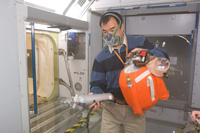
Astronaut Noguchi entering the fire site
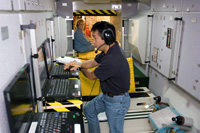
Astronaut Wakata confirming the location of the fire
Astronauts Wakata and Noguchi, along with NASA Astronaut Timothy Creamer, an ISS Expedition 18 back-up crew member, participated in ISS Emergency Training on the procedures to use in the event of a fire during a long-duration mission aboard the ISS.
The training was conducted in the ISS full-scale mock-up training facility at NASA Johnson Space Center (JSC). The training simulated actual fire and smoke conditions with real smoke. The astronauts followed procedures for responding to a fire emergency by donning oxygen masks, locating the fire by using smoke detectors, suppressing the fire, and locating other astronauts.
International Space Station (ISS) Expedition Operations Training in Russia

Astronaut Wakata operating the amateur radio equipment(©JAXA/GCTC)
Astronauts Wakata and Noguchi participated in operations training on the Russian modules that constitute the Russian segment of ISS at the Gagarin Cosmonaut Training Center (GCTC) in Russia.
They attended lectures and used simulators to learn operations of the Russian segment of the ISS, including operating the Life Support System, Navigation and Attitude Control System, and the amateur radio equipment.
ISS Emergency Procedure Training
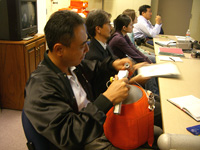
Astronaut Furukawa during training
Astronaut Furukawa participated in ISS emergency procedure training at NASA Johnson Space Center (JSC). This session covered the procedures used by ISS long-duration Expedition crew members in responding to emergencies, including ammonia coolant leaks, fire, and sudden air decompression.
Astronaut Furukawa, assigned as a Crew Support Astronaut for the ISS Expedition 18 crew, participated in this training session so as to better understand the procedures the ISS Expedition crew members should use in responding to emergencies. Astronaut Furukawa will serve as a Capsule Communicator (CAPCOM) at the Mission Control Center (MCC) at the Johnson Space Center (JSC) during the Expedition 18 mission.
During the training session, astronaut Furukawa received instructions on the procedures for responding to emergencies, including using the IVA Ammonia Detection Kit and wearing gas masks.
Lecture by astronaut Wakata during the 40th anniversary commemorating the establishment of the Japanese School in Moscow
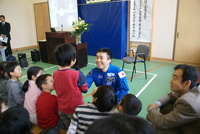
Astronaut Wakata answering questions from students
Astronaut Wakata visited the Japanese School in Moscow during the commemoration of the school’s 40th anniversary and gave a lecture.
Astronaut Wakata talked about his experience in space from his past flights, and his dreams for space, as well as his dreams for the ISS and Kibo, in his lecture titled, “Current status and future perspective of manned space activities: Toward installing Japanese Experiment Module Kibo on the ISS.” Students attending the lecture asked astronaut Wakata several questions about living in space.



